I was looking forward to this route, hard but beautiful. In self-sufficient mode, that is to say, tent, kitchen, bag and so on, but open to eating in restaurants if there are any. The idea was to cover a lot more kilometres over five days at Easter, but it wasn’t possible, so I shortened it a lot, leaving out the basics, and it was only a two and a half day long weekend. And thank goodness, because I ended up exhausted.
I left the worst for the first day, knowing that it would be cooler. Let’s say it was a kind of cyclo-trekking or cyclo-climbing where I knew that many sections would be “push-bike”, and even “lift-bike”, some of them lasting more than an hour. The other two days were mountain biking, sometimes hard, but almost all the time you are riding, although sometimes at five kilometres per hour when loaded.
DAY ONE
I park in Tamajón late, buy bread and make myself a sandwich because it’s already mid-morning and I’m hungry. I attach the panniers and tent to the bike. A quick check shows that a small, badly sealed bottle of Irish whiskey that I had in a saddlebag on a jacket has been knocked over. Great, I’m going to smell like an alcoholic beggar. Good thing I’m not here to make friends. I leave the jacket in the carrier to air it out a bit and let it dry – and the empty flask in the car, a pity – and off we go.
After appreciating and walking around the enchanted city (like the one in Cuenca),

I take a GR (Gran recorrido) trail with some non-cyclable sections towards Campillejo, which I soon change to the road. Then I see that the path has turned into a good track at the bottom of the valley and I regret it, but it is only a few kilometres and the road is empty and beautiful. It passes through a geological fault line from the limestone area of Tamajón to the slate area that I will follow for the rest of the trip. The original idea was to make a huge detour through the juniper forest north of Tamajón, visit Almiruete and return to Campillejo, but I already know it, and now I don’t have much time.

Mmm, where the hell does the path go?
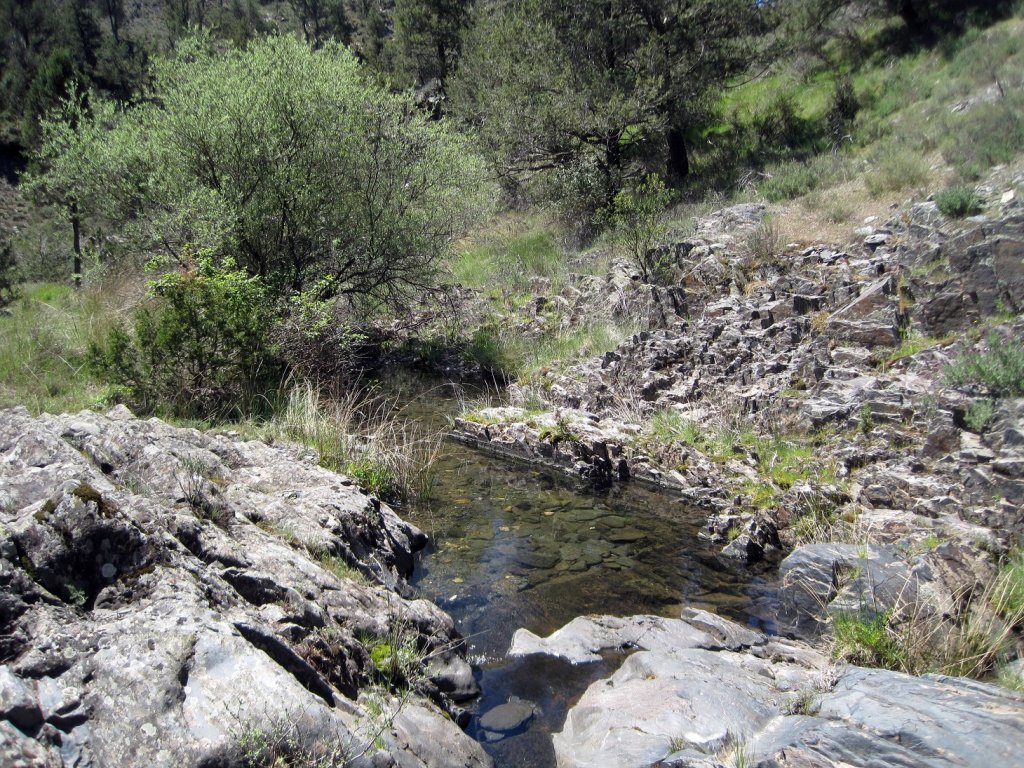
I leave the GR and take the road. On the right I can see the Ocejón. A shiver runs down my spine. I’m going to pass right next to it in a few hours.

From Campillejo, the first village with black architecture, there is a good track towards Majaelrayo, they call it GR variante or something like that. It goes through pine woods, and it is curious that there are many with part of the bark torn off, always on the south side. At first I thought they were the result of wild boar scratches, but when I saw more I assumed they were to extract resin.

But before reaching Majaelrayo, take the turn-off to Ocejón.
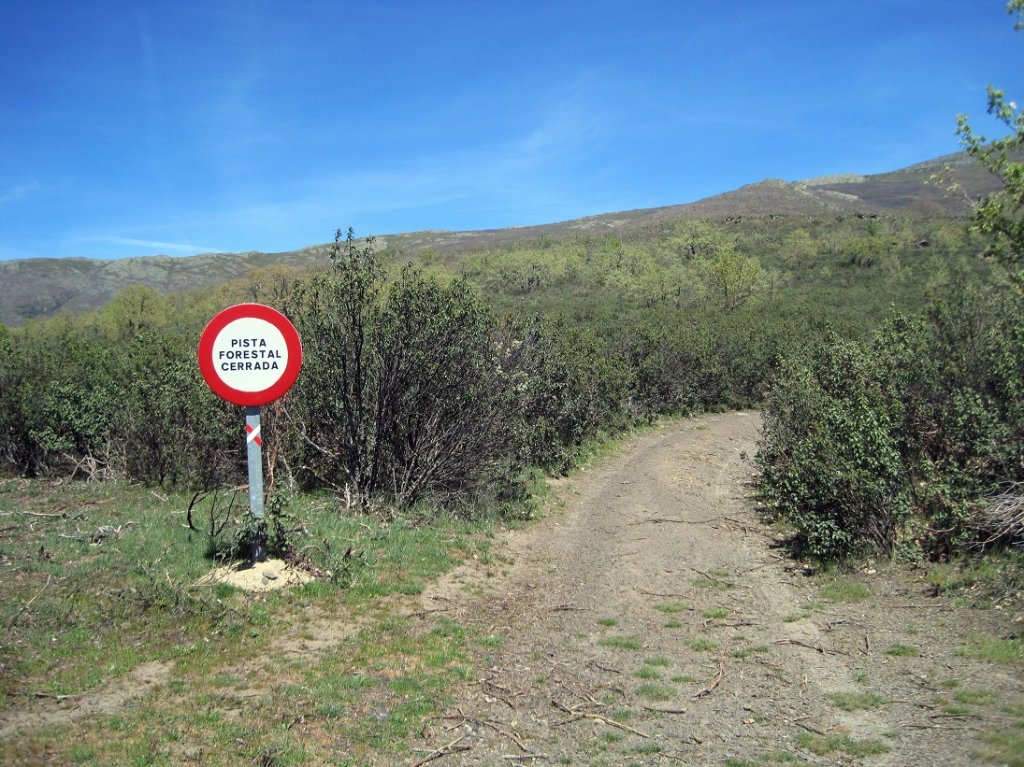
The climb can be done riding (and loaded) about two thirds of the way up. I strained my legs a bit and ended up with cramped thighs and calves and sore knees for the rest of the day, but the walk and the views are worth it. The worst thing is that winter has just left these lands and the oaks have hardly any buds, the landscape is still wintry in May.

Majaelrayo from the Bernardo crag. You can see the white track coming from Cantalojas, where I will come the day after tomorrow. There are two tracks because a little further north it forks and joins again in the village.

First bearberry. The snow has just gone, leaving a green blanket. It is not grass, it is also called here “gayuba” and grows only at high altitudes. It stays green all year round, even under the snow.

In the meadow of the madita I take a well-deserved rest lying on the bearberry in the sun. From then on I don’t even try to get on the bike, and there are times when I can’t even push it, I have to lift it. I should look for some kind of harness to put it on my back so that I can use my hands in these cases, hehe. It’s a good thing it’s only 500 metres.
I don’t climb the Ocejón, of course, but I pass the col next to it, with the peak less than a kilometre away and about 250 m vertically. I see a few hikers who are amazed and take pictures of the bike. Although it’s not for less, it’s very sexy between those mountains.

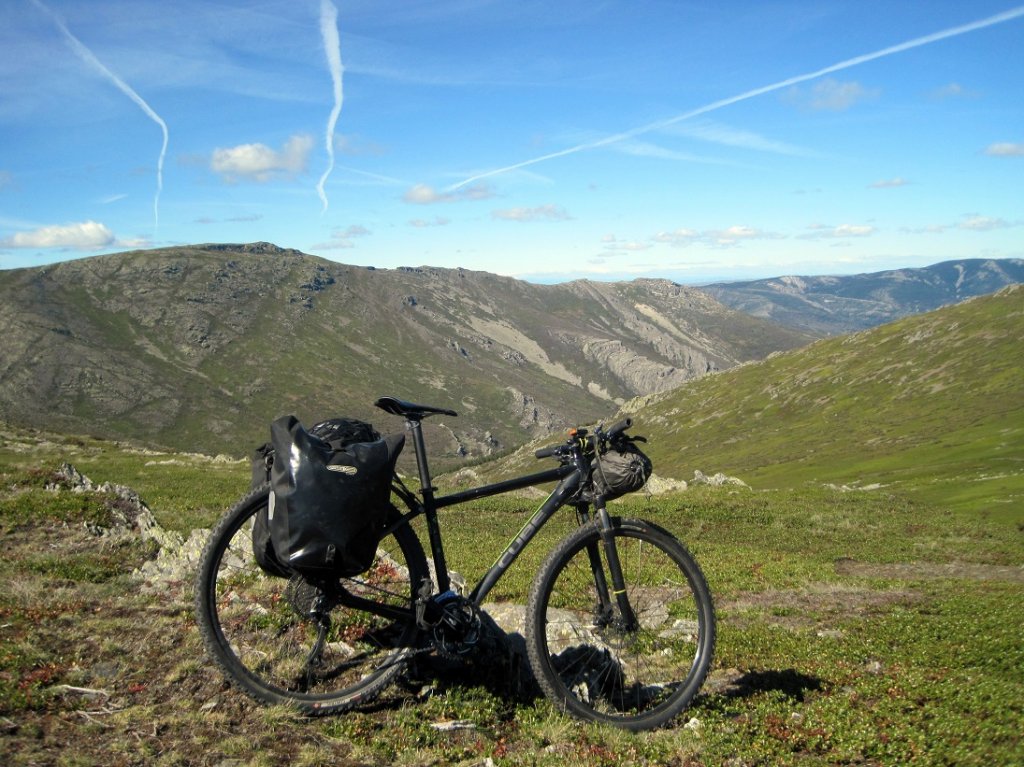
It’s windy as hell, I can barely get the bike in place for a moment for the photo before it blows away. And I have to hastily put on my perfumed warm clothes. They’re going to think I’ve gone up the hill drunk…
Now the problem is to go down. Everything that is not bearberry is slate slabs that go “clap clap clap” as they pass. You have to be careful because some of them are very big, the edges are vertical and the wheel doesn’t go through. If you get up to speed and brake quickly, the slabs move with you. The thing is that I fell, at low speed but it hurt. The wheel didn’t go through and I fell sideways, like a beginner. I only bruised my arm a bit. As you go down, the bearberry disappears and there is more vegetation.

Then there are some very big rocks that make the descent more difficult. In the end I develop a half-suicidal technique and in very uneven sections I stand with all the weight on the right pedal and with the left leg doing the work of a rafting paddle, leaning on the rocks to save steps and help the brakes. Against all odds I was quite safe and much faster than walking, although it is tiring. There are sections where you have to get off, of course.
Then the terrain is of a less “slaty” slate, more golden and somewhat more cyclable. The villages on that side of the sierra use this stone and are of a more golden black architecture, incredibly beautiful.

Passing through Los Chorros, with a lot of water, near Valverde de los Arroyos.
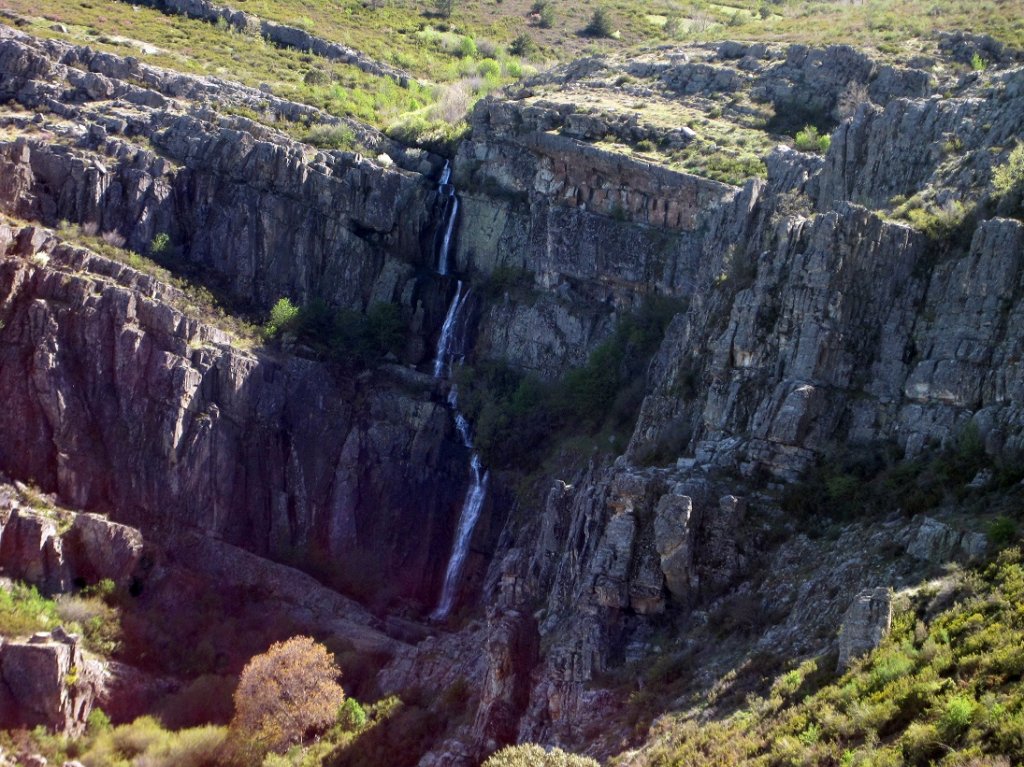
From there on the path is almost normal. I’m late for lunch in Valverde, but they prepare me a wonderful and enormous sandwich of loin with peppers, which with a beer takes away all my ills. I haven’t taken any photos of Valverde de los Arroyos, because I’m not a good photographer, but I recommend you to google the name of the village and enjoy the images.
Without being able to enjoy Valverde too much, because time is running out, I take a track to the north that takes me to the valley of the river Sonsáz. There I turn off the track and go down to the river along a small path almost covered by rockroses and gorse. At the beginning it goes more or less well, but when I get to the river I get off the bike and get scared after a stick gets my spokes stuck. Besides, you can’t see the rocks because of the high vegetation, the path gets steeper and zigzags, and it could be a big shock.

I found the bridge of La Mata, it is not a myth, it exists. Everything I had read about it is from several years ago and I was happy to see that it is still standing. It seems that some fishermen still come down.

I relax and take a short break. The evening light is perfect and I feel very good. The river that roars a little further down is absolutely calm here.

From there it gets worse, and I find it hard to follow the road. Not just walking along it, but knowing where it goes. A few kilometres of hard portage where I have to open up the track, it’s been years since anyone has passed this way. The vegetation rips off the bottom of the rear derailleur cable casing and leaves the front one blocked, among other small inconveniences, although I’ll realise that later. Good thing the saddlebags are tough (and I’m stubborn). Just as well I’m wearing jeans over the expensive bib shorts (anathema, damnation, a biker in jeans!). If it hadn’t been for them, the branches would have stripped me naked in minutes. I even ended up with my arms full of scratches. But what a views, gentlemen.



I finally reach a place with a flat surface to pitch my tent, the abandoned village of Robledo de la Mata. There are only a few small remnants of houses left, you can see where there used to be a door, some wall remains. All the stones of the houses have been used to make huge corrals where cattle go up in summer (they go up through another place, of course).
I camp and make myself a refreshing dehydrated fideuá and go to the bag, as it’s cold. The night is a bit busy, with a nocturnal visit from a bellowing wild boar, and me shouting at it (from inside the tent, of course) to get it out of there. I guess she was in heat or something, because other times it has happened to me and as soon as they hear the noise of the sack when they wake me up, they stampede out. This one spent about a quarter of an hour banging his head off, going up and down, “oegrhhh, oeghrrr”. I hope it wasn’t me that made him horny… In the morning when I woke up I saw the biggest tick in the world, the mother of all ticks, which looked like a black widow – the spider, I mean – walking on top of the tent’s mosquito net. The truth is that I admire those who bivouac. In the high mountains or on a beach, maybe, or maybe I’m lucky, but I don’t sleep without my tent. I know I’m missing out the stars, but…

DAY TWO
I have some slices of grilled bacon for breakfast with bread and tea, and pack up the camp. As I set off in search of the way out, I find myself walking through a field covered with mushrooms.

Robledo de la Mata from above. You can see the corrals that have used all the stones of the village.

It takes me a while to find the track that leaves the village, but I find it – I think I must have passed over it three times without seeing it, even though on the map it’s just as wide as the main road – only to realise then that the gears don’t work. Of course, since they broke I haven’t changed from the small chainring and big cog. Well, actually since they broke I’ve only been on the bike for about ten minutes, this morning when I finally found the road that led to the track. And I only got on out of pride, because it was like walking.
It’s OK, I carry everything, even cables if necessary. I dismount the saddlebags and turn the bike around, and in a while everything starts to work more or less decently. At that moment I see something out of the corner of my eye, and when I look up I see six or seven vultures circling above me at a low altitude. Buff, they are beautiful – very beautiful, and at that distance even more so – but I hope it’s not a premonition of anything. I took some photos of them that turned out to be very suggestive blurs. I definitely have to start learning how to take good photos.
My original idea was to leave the main track when the Sorbe valley turns almost 90 degrees to the west, ford it and climb north towards the area of Galve, and from there to Cantalojas passing by the remains of the castle of Diempures, which even has a ghost.
OK, I’ll tell you…
***** The haunted castle of Diempures***************
An old Celtiberian castro that will be many more than two thousand years old -at least what is left of it-, which was destroyed and rebuilt many times, always with slate like all the constructions in the area (or the walls of Lugo). It is one of the few slate castles there are, although I have seen one on an island in Ireland against the Vikings (they call them forts).
It was later Arab and then Christian. It seems to have been an important frontier point since ancient times, with its bridge over the Sorbe and all, now disappeared. I imagine that it is similar to the toll booths on the motorways nowadays.
At the beginning of the 14th century it was run by Don Iván de Zúñiga, married to a young Basque noblewoman related to the lord of Guadalajara, Isabel de Mendoza. They took in charge of her out of charity a distant relative of the same age who had just been orphaned, Alonso de Vargas (it was then common to be orphaned overnight, whether by plagues or more properly human reasons, such as daggers or swords).
At that time the king of Castile, Juan I, believed he had rights by marriage over the kingdom of Portugal and was preparing to claim them, but the Portuguese, or rather, certain Portuguese nobles (everyone knows that a peasant has no preferences, the wolf that eats his sheep, whether black or white, is just as much of a hideous wolf) asked for help from perfidious Albion and got a king out of their sleeve, also called Juan I, which made war cries a lot easier. All you had to do was take turns shouting “for King John I” and everyone was happy. And you saved yourself a hoarseness, hey.
It is not clear what the English charged, who do not usually act for free, possibly more or less what the Castilian would have got if he had won, but at least those who paid had the wolf’s job for sure. The fact is that Don Ivan died in battle – that of Aljubarrota.
When the news arrived at the castle, our dear orphan thought, as it is said nowadays, that crises are moments of opportunity, and he took the opportunity to take over the place, taking advantage of Doña Isabel’s post-widowhood depression. And when he was master of the domus, the next step was the domina. Isabella refused to accept his advances until one night when Alonso entered her bedchamber, claiming his rights as lord. Our heroine escaped by climbing the tower. (Stupid, yes. In her defence it must be said that the castle was very small and the doors were locked at night). Once they were both up there, Isabel preferred to stick her dagger in herself rather than lose her honour, (although evil tongues say that he was carrying the dagger and in certain circumstances one doesn’t know where to put one’s hands). The thing is that the reason reached Alonso’s brain and, horrified, he staggered backwards with such clumsiness that he fell from the tower, over the cliff and left his brains on the stones of the Sorbe river. He was found the next day half-eaten by wolves, and since then his cries of repentance have been heard howling at night in the vicinity.
Well… a good script, isn’t it? They don’t need any Shakespeare in the Aillon mountains.
From that time onwards, the roads changed their routes and the castle was left in the middle of nowhere, or at least nowhere in traffic, and what remains of it is a large gate with arrow slits and the foundations. And the ghost, of course… Well, and a lot of rural hotels that are called like that.
*****end of the haunted castle ****************
OK, I’m getting lost. Back to the route.
We were thinking that I had to ford the river, but it carries too much water and the ramps I see on the other side don’t help, so I decide to follow the track to the west and cross the sierra through the valley following the Sorbe gorge. It’s a long and steep climb until I reach a sort of plateau where, incredibly, the path is almost flat for a while. It is also beautiful, I have the impression of cycling through Switzerland.
Sorbe gorge. Impressive

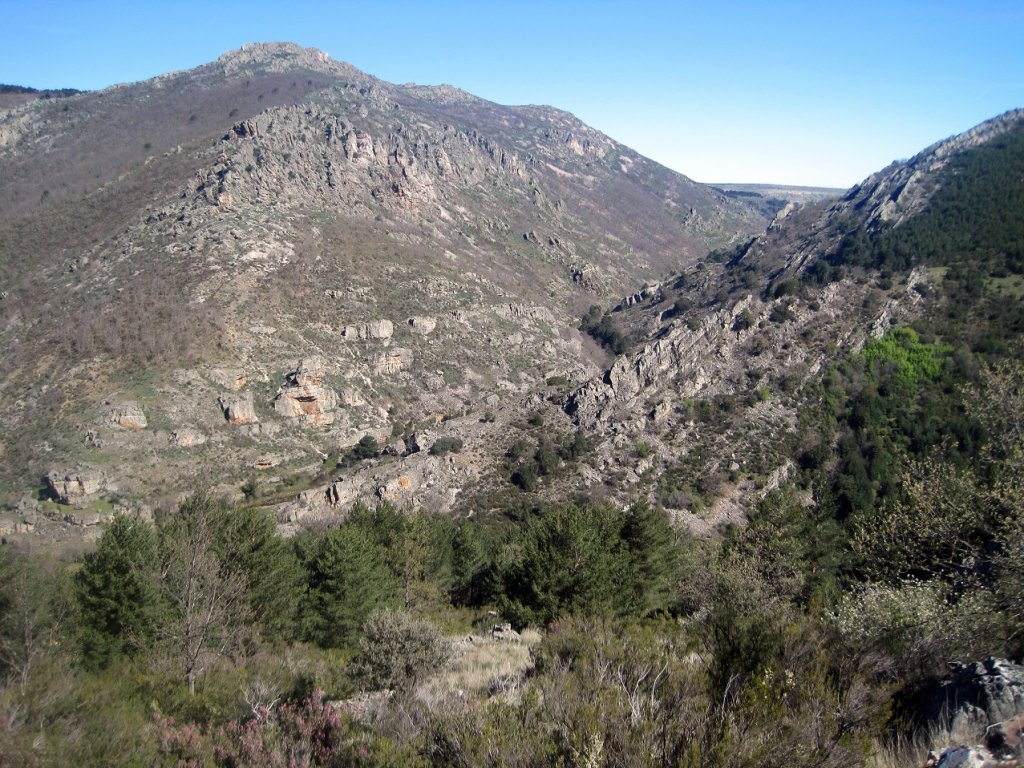

I get hungry and stop for an Iberian energy bar from Guijuelo.

Climb up to the plateau.
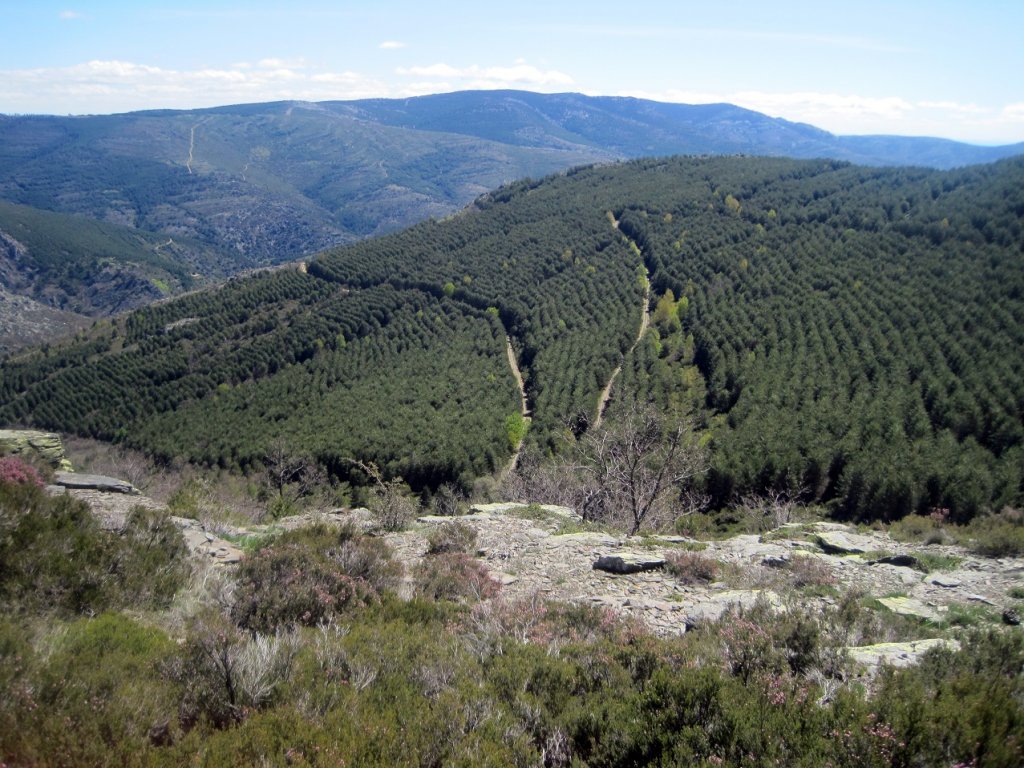
I am at the top, at almost 1700 m, but the pinilla peaks in the background make it look like a valley. In reality, vertically, the same metres separate me from the water of the Sorbe river that I have left to my right as from the summit of those peaks.
I enjoy the track, fast, smooth and flat, I smile as I pedal.
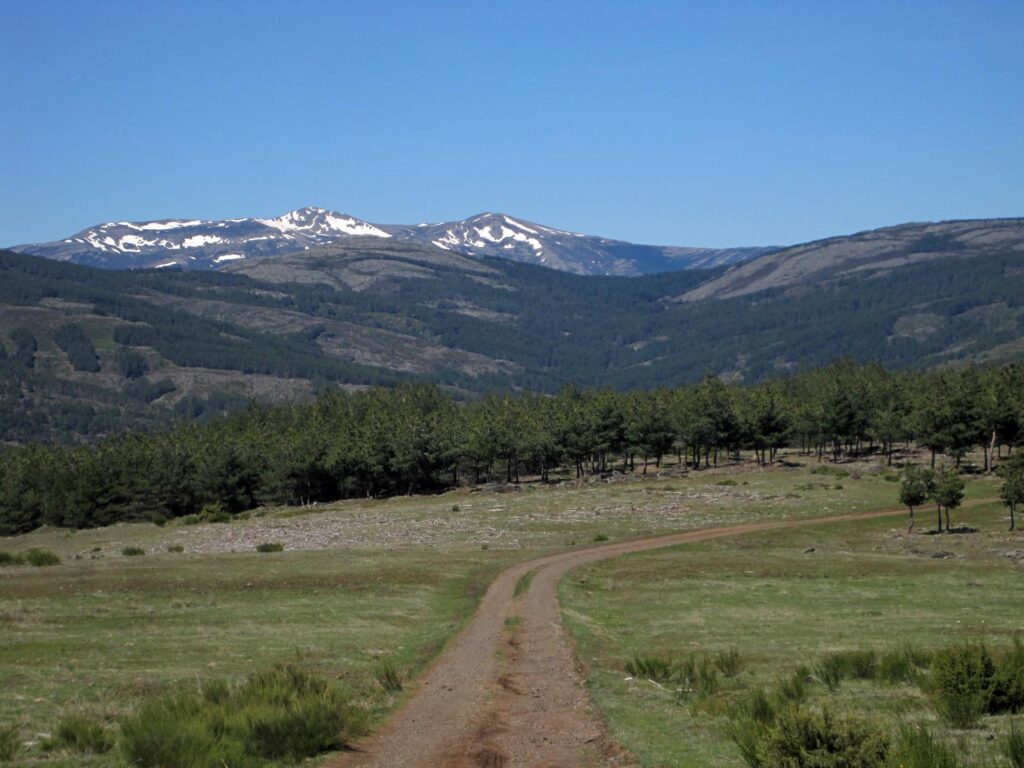
I get off on the famous white track from Cantalojas to Majaelrayo, and head north. I descend a lot, and I worry because tomorrow I’ll have to go back that way. I’m approaching Cantalojas and I find some beautiful, exhausted cyclists at the top of a mountain pass, resting for a while. They’re the first people I’ve seen since yesterday in Valverde.
Greetings and laughs.
I stop and eat something in Cantalojas, expensive and quite improvable – I guess I’m in the wrong place – but it feels good, and head for the Tejera Negra beech forest. With the intention of leaving my luggage and enjoying the natural park, I stop at the interpretation centre, but there’s nobody there, so I grit my teeth and start to climb with all the equipment. The park is beautiful, the only downside is that the beech trees are only just budding. In a few weeks it must be wonderful (and in autumn, of course). I enjoy myself like a child, and I even take a detour that leads me to more dense and equally bare beech forests.
Exit Cantalojas and entrance to the Tejera Negra beech forest.


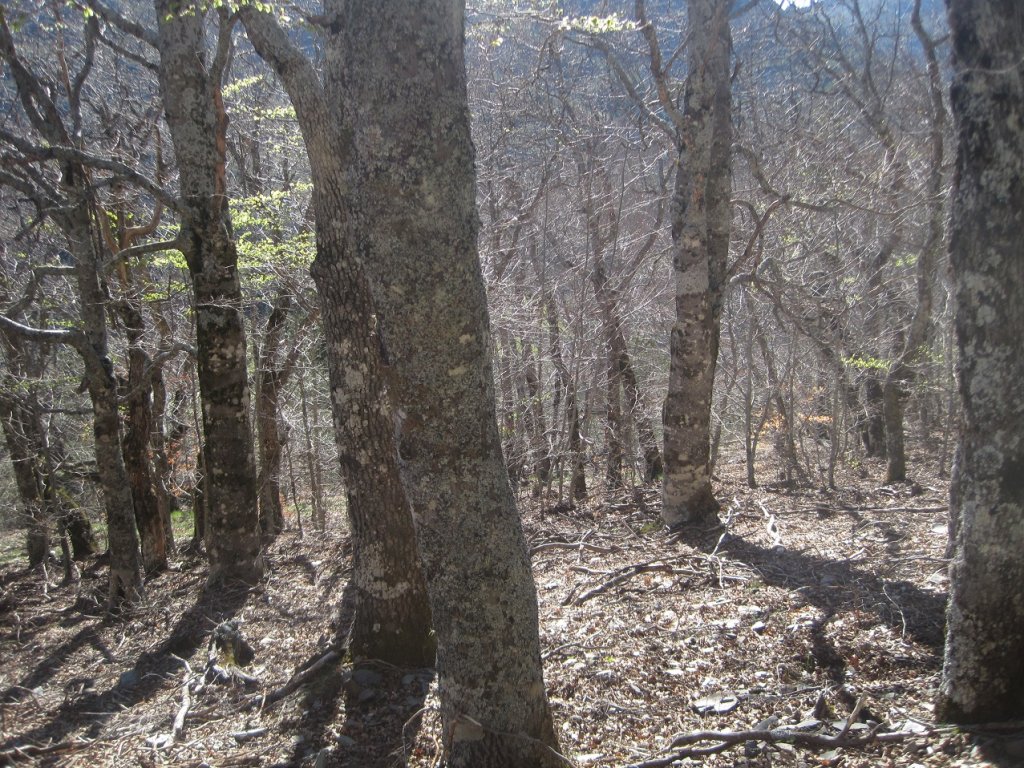
On the way back I find that the Cantalojas campsite is closed for renovations – a pity, I needed a shower -, so I take the white track again, this time heading south. We leave Cantalojas…

The time is upon me, there is little daylight left, and I arrive at the place where I met the girls this morning. I see there a bottle almost full of water standing on a stone (theirs, of course, not many people come here). It’s a miracle because I’ve just realised that I’ve used a lot more water than I thought and my camelback is almost empty, and I was thinking of going back to Cantalojas to fill it up -horror-. I take it as a divine sign and get off the track and camp. Risotto with mushrooms, surprisingly good for dehydrated food. No wild boar tonight. At midnight I have to go out to meet nature and I am stunned by the number of stars. There can’t be more, there is no place where there are no white dots, it’s fascinating. I stare at them for a while until the cold sends me to my sleeping bag. When I wake up in the morning, the fabric of the tent is crunchy from the ice. It’s fucking May, and I’m in a sleeping bag of up to 10 degrees. I slept with all the clothes from the panniers on.
DAY TREE
The next day I continue on the white track. This track is famous among cyclists. It is gravel, very white in some sections. It has three strong passes, especially the second one, and in winter the ice is camouflaged by its colour, which together with the ruts that the water makes over time and the loose stones, makes it a lot of fun.
The sun thaws the frost on the grass as it fills the shadows and turns the climbs into a sauna, but before each descent I have to put on my jacket (with Celtic scents) and gloves. And I’d wear a hat if I’d brought one, the air makes my head ache with the cold, it’s May, dammit! I reach a recreational area with an idyllic stream and take the opportunity to shave and wash myself a bit. Even my most noble parts, which after two days of sweating and pedalling are so grateful. Naturally, I didn’t leave any traces of my passage. Not even foam.



A good climb and one more long descent and I arrive to Majaelrayo. The name of the village is curious, it literally means “where lightning strikes”. A good second breakfast and local chat. I like the atmosphere of these villages.


I continue on tarmac to Campillo de Ranas. Majaelrayo is more touristy, but Campillo has more “native” life. And even pubs. I then continue to Roblelacasa, beautiful, from where I return to the track.


And finally I arrive at Roblelacasa, old memories…

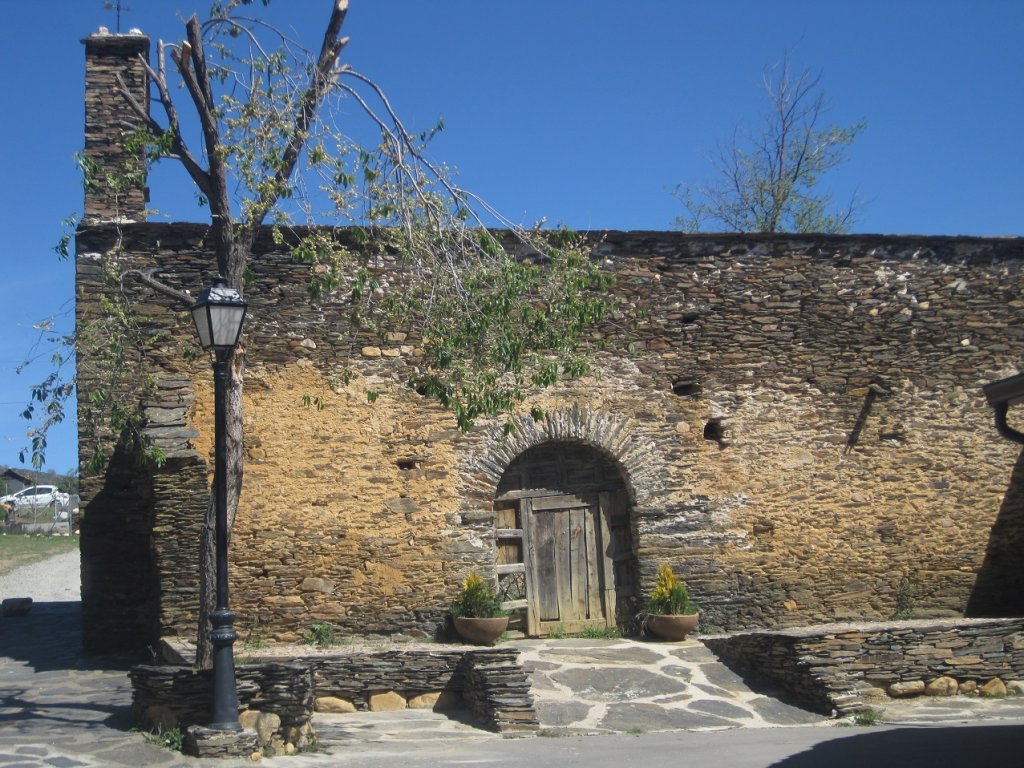
At Roblelacasa I stop, eat something on a bench in the shade and fill the camel with water. Memories come to my mind by themselves without calling them. From a long time ago…
I remember arriving here 25 years ago, hitchhiking with a girlfriend. There the road ends and the path to Matallana begins, where there was a big party going on for several days, which was our destination. To enter the village at that time a gate had to be opened to keep out the cows, if I am not mistaken. Not many cars were – and are – passing through, so we arrived tired and thirsty. We saw an inviting gate open onto a patio with the floor inside full of bottle caps and some empty beer crates and our faces lit up. We went in and there was only the barman and a customer, and we ordered two cold beers.
The barman started chatting with us and gave us two more beers when we finished, without asking us. They were both smiling and we were happy, but there was something strange. We didn’t realise until the third beer that we were in a private house, that there was no bar in Roblelacasa and that we were being taken for a ride. There was a lot of laughs, they invited us to eat and then accompanied us on the road to Matallana (with a good supply of beers in our backpacks). A few days later, on my return, I slept in the house and the owner showed me around. The whole of the upper floor covered by the slate roof, it was open plan, without partitions, and had pigsties under the roof, the pigs were upstairs in the old days in winter, plus the storerooms. I remember a huge oak beam going down to the main floor to a slate pedestal. The beam didn’t touch the stone and you could pass a piece of paper between the wood and the pedestal, except when the loft was loaded in winter, and then it did support the wood. I was impressed.
I think I found the house where it happened, but it was locked and I wasn’t sure, and I didn’t dare to call…
So I took the road to Matallana, 25 years later…

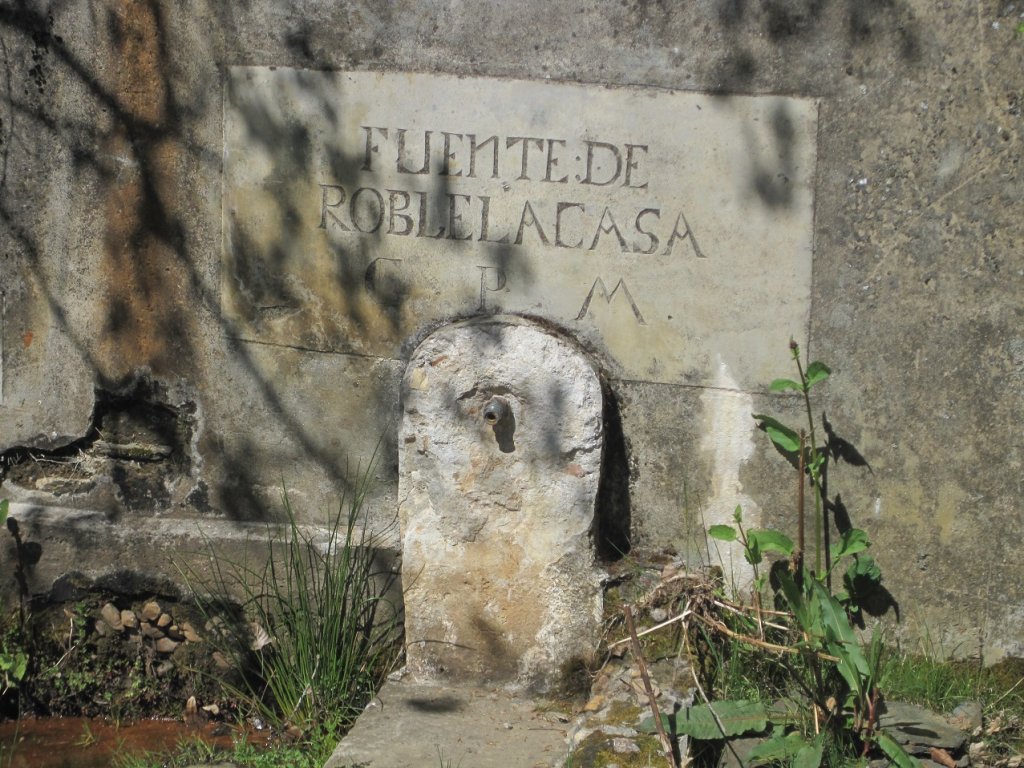
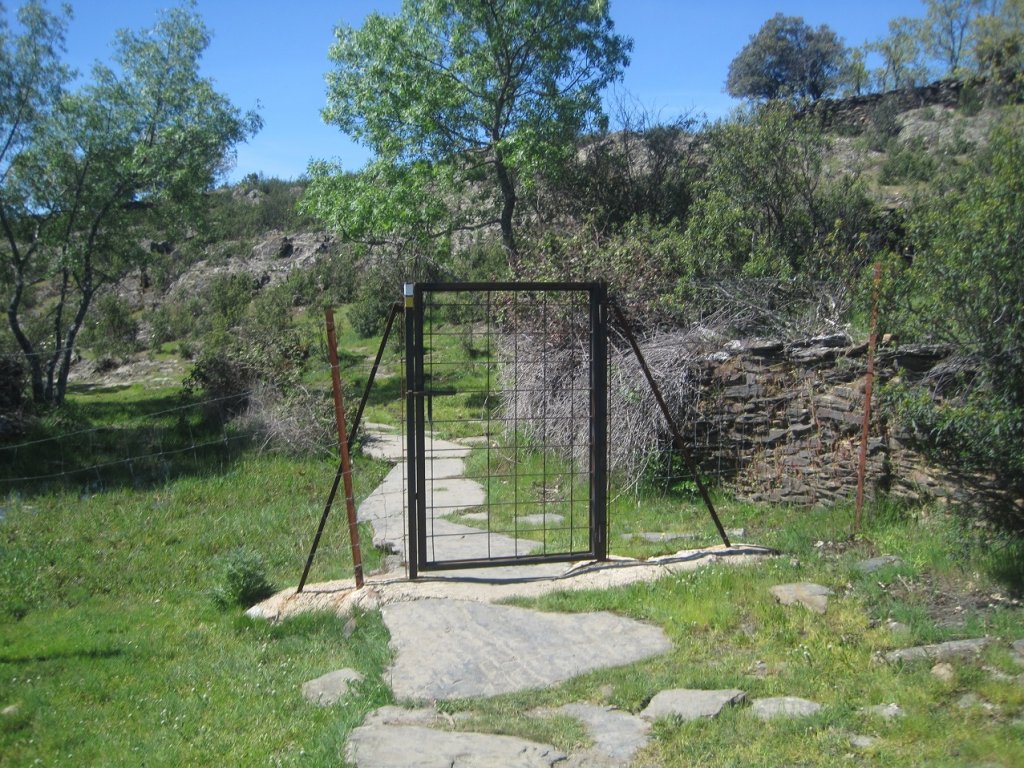
The beginning of the road to Matallana is stony and difficult, as I remembered, but then they have widened it enormously up to the Matallana bridge and a car can pass perfectly well.

At last I can see the bridge over the Jarama from above. I won’t cross it yet, because I want to detour to the Aljibe waterfalls. The bridge has been rebuilt, I guess they widened the track to allow the necessary machinery to reach it.

Waterfalls of the Aljibe. Lots of water, scary to swim in, but at least I get my feet in. The term “cold” does not do justice to the temperature of the water.
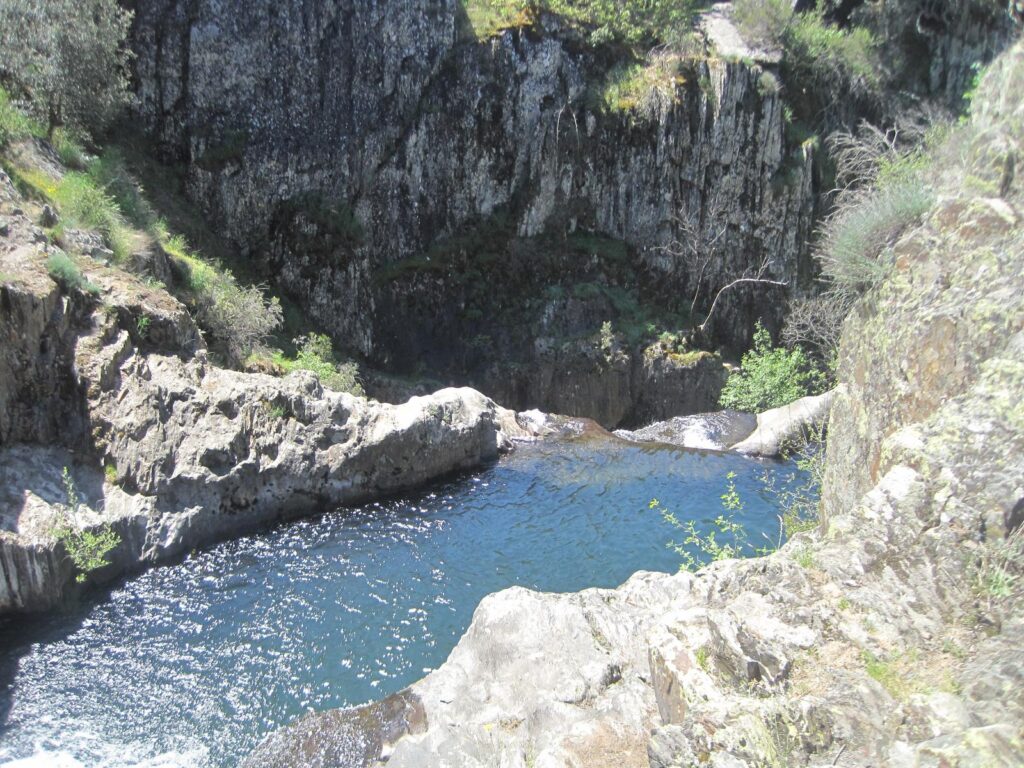

The road to the waterfalls is a bit tricky, when you are not in mud you have a precipice on one side that falls directly into the Jarama.

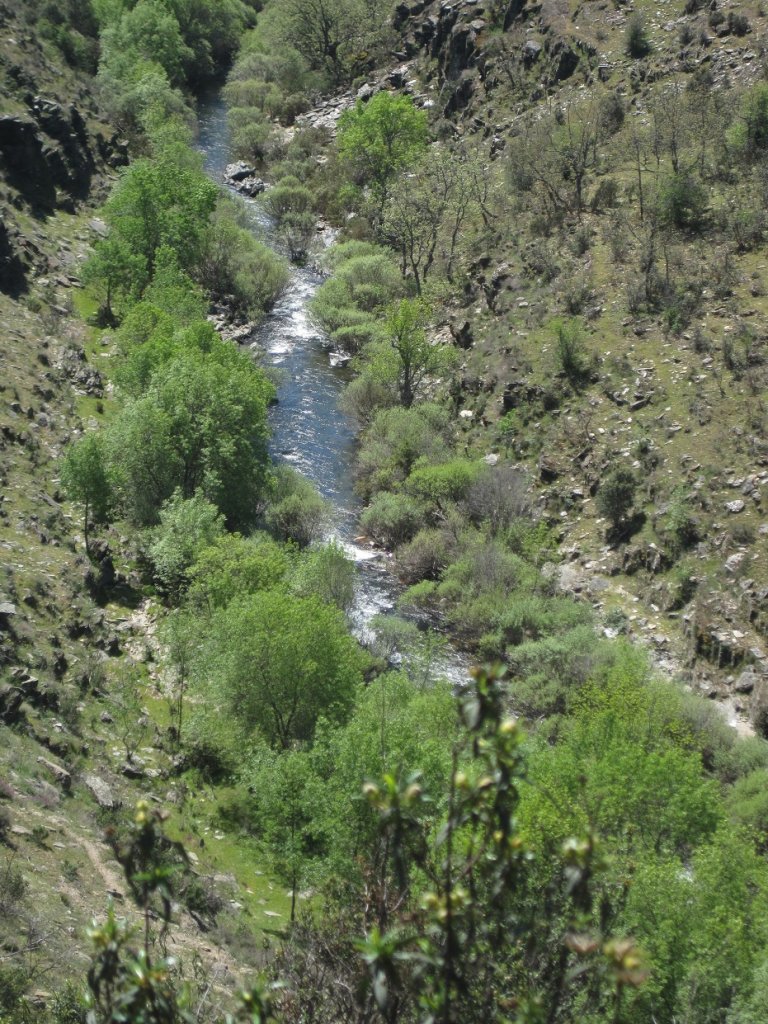
Well, now I will cross the bridge. They’ve done a thorough overhaul, it seems that hiking is being encouraged here.
They have built a new bridge (with a railing!) over the old one made of old threshing slate, although they have been kind enough to leave the old one underneath. You can see perfectly where they have added more layers of slate to the columns. The last time I crossed it was over the old bridge that is still underneath. An “interesting” experience. When I see these bridges I imagine the days spent and the working conditions of the locals piling slate on two tall columns to make the bridge. Different kind.

From the bridge I take the climb to Matallana. It’s harder than I remembered, and I have to get off the bike fin some sections.
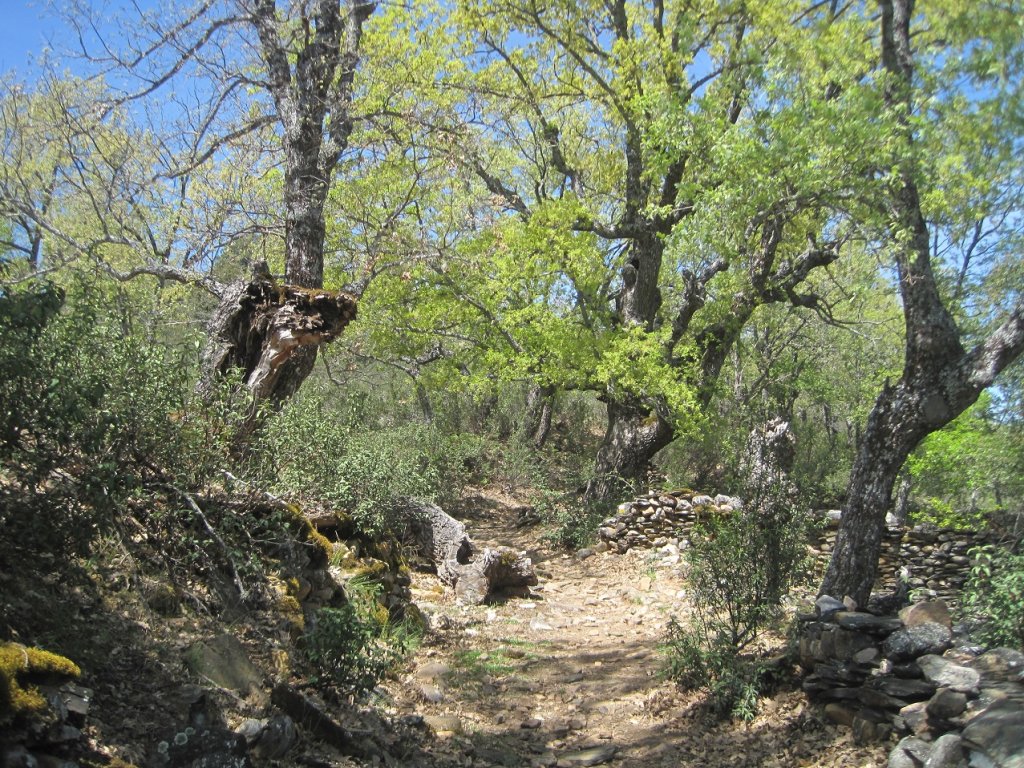
I pass through Matallana. I don’t know anyone there, of course. There are young people, there are vegetable garden… there are few.
A pity, I knew this place with more than a dozen squatters, where I helped make bread and clean garlic, milked goats, and had parties… I’m old. It’s amazing how hard it is to rebuild a house and how quickly it falls apart when you abandon it. At the first hole in the roof the water makes its way in and in a few years there is only ruin. I remember one occasion when we each brought dozens of metres of hose on our backs to channel water from a spring to the village.
I didn’t want to aks the boys, I didn’t want to soubd like a grandfather. But I got a good impression, they work hard and the gardens was well cared.
I get a bit lost and go down the wrong track. It’s embarrassing because I’ve passed this way a few times, but hey, it’s nice.

There should be a gate here. But nobody uses these walls anymore

I retrace my steps and take – this time – the good one. I set off for La Vereda, another abandoned village.
After a little up and down I arrive at the Vereda.
When, in the middle of the last century, all these villages were being abandoned, the Institute for the Conservation of Nature (ICONA) was in the middle of a process of pine reforestation throughout the country. In order to avoid problems with inheritance rights and communal pastures, ICONA’s policy was to expropriate the villages completely once abandonment had been demonstrated. Horrible things happened, such as the last inhabitant of a village, maintaining the right to the village’s property, selling all the oak or holm oak trees of the common pasture to a timber company before going to Madrid or Guadalajara with a good economic bonus.
The first Spanish “progressives” and hippies who started to occupy abandoned villages had to deal with ICONA.
In the case of La Vereda, a group of university students joined forces and bought it from Icona. The difference with Matallana is that here they are owners, in Matallana they are squatters. And that there is more money, of course. And that it is only inhabited at weekends, mostly.
The truth is that the village is very well kept, it is beautiful and looks like a fairy tale. It has hardly changed, if anything for the better.

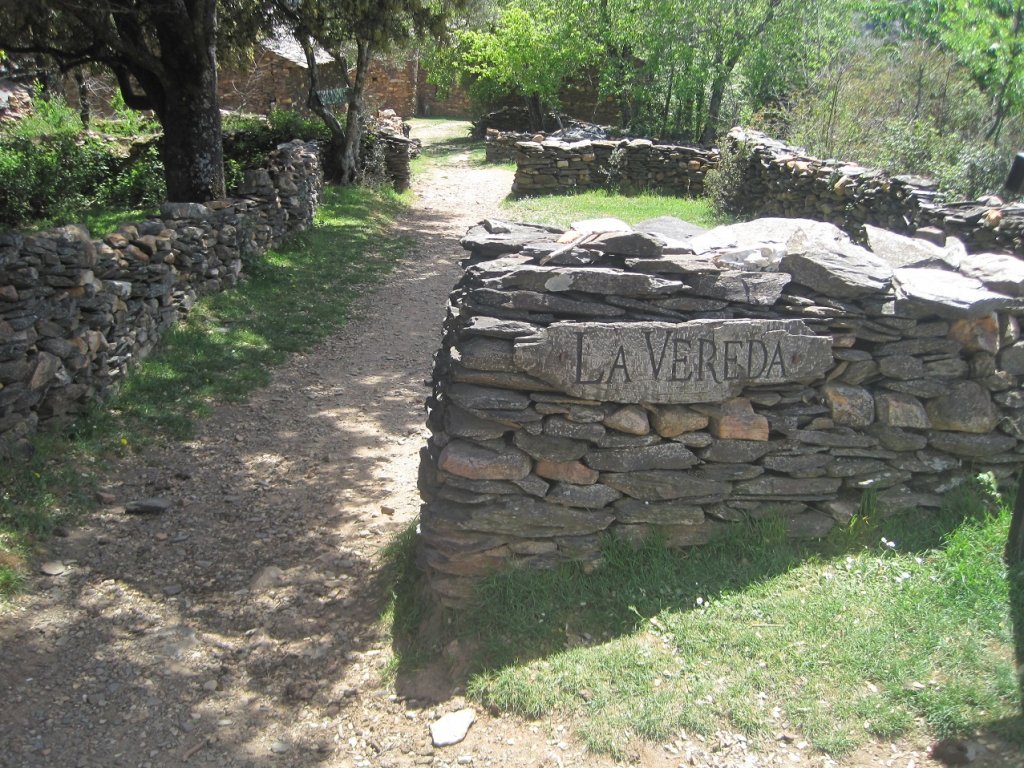




Well, after enjoying the place and talking and reminiscing with an inhabitant I met, I set off for the Vado reservoir, a brutal descent to the river, followed by an equally brutal climb, of course. There is no word for “flat” in these parts, although I suppose there are many local varieties of “slope”. The track seems to have more zigzags than the ascent to the stelvio, or so it seems to me, as I’ve been going up and down for three days now.
At the end of a ramp, I see the swamp.

One more climb, and I get to the top. Now all I have to do is gracefully slide down the track to the reservoir walls, trying not to go too much over 30 km/h, as I’m loaded and a swerve is fatal.

I pass the dam over it, it still looks like a Swiss lake if you don’t look at the concrete.
Flooding a place called “el vado”, a place where wagons and carts used to gather to cross a river, where a village was created from the stalls where muleteers refreshed themselves while on duty, is like pouring anthrax into a hospital. All these villages were abandoned when the natural communication with Tamajón was cut off. Even today there is still a road called “camino de los arrieros”, which connected this area with the valley of Lozoya, in Madrid, and which gave life to these villages. Now it is only used by hikers and the seprona jeep. And on top of that they have the indecency to call it the Vado dam.
Anyway…
The gps died hours ago, so I ask a local and, naturally, he gives me the wrong directions. I make a mistake and go along a small road along the lake until I see that something is wrong. I turn on my mobile and there is coverage, and I see the error.
I turn around and follow another road to the beginning of the track to Tamajón, the last track and I’ll be in a bar with beer, courage..
When I get to the beginning of the track it’s not very encouraging, but I grit my teeth and start to climb.

Here appears a phenomenon that was torturing me all the way up. There is a species of small flies whose only aim in life is to get into the mammal’s eyes. First one appears, then two, and within seconds you have a cloud of little flies flying around your eyes and getting into them at the slightest opportunity. I guess it must be a religious thing. To pass into the afterlife “beyond the eye” they have to become a holy sleep in the eye, or something like that.
I put on my glasses and it solves the problem of the instantaneous creation of eye-lashes, but as many as possible land on the glass while their friends continue to flutter around. You can’t go around slapping your hands because, as well as being useless, it throws you off balance and you can fall. You have to appeal to your zen self, “be water” paquito, relax and suffer your flies in silence.
However, at one stop I noticed that when you relax and breathe normally, they disappear. I immediately came to the association panting = flies. They must have some very sensitive sense to the carbon dioxide in the breath, the signs of their god are preceded by that wonderful CO2 scent and, following their trail, they will reach the great eye of salvation.
But it’s hard not to pant going up these hills. In the end I find a compromise and perfect the technique of riding as slow as possible, I manage to balance the bike well at about 4.5 km/h without falling over and using as little energy as possible. It works, and instead of an irritating cloud I have only six or seven flies on my glasses, which is more bearable.
It’s a bit tedious, yes, but at such unsporty speeds there are moments when I forget that I’m climbing, I’m immersed in my thoughts, and suddenly I feel that the bike is going by itself and I’m going downhill and I haven’t noticed.
Anyway, the track changes for the better:

and I can start going much faster and without expelling so much CO2.

Until I reach the turning point and see a descent to Tamajón where I can forget about flies and gods.
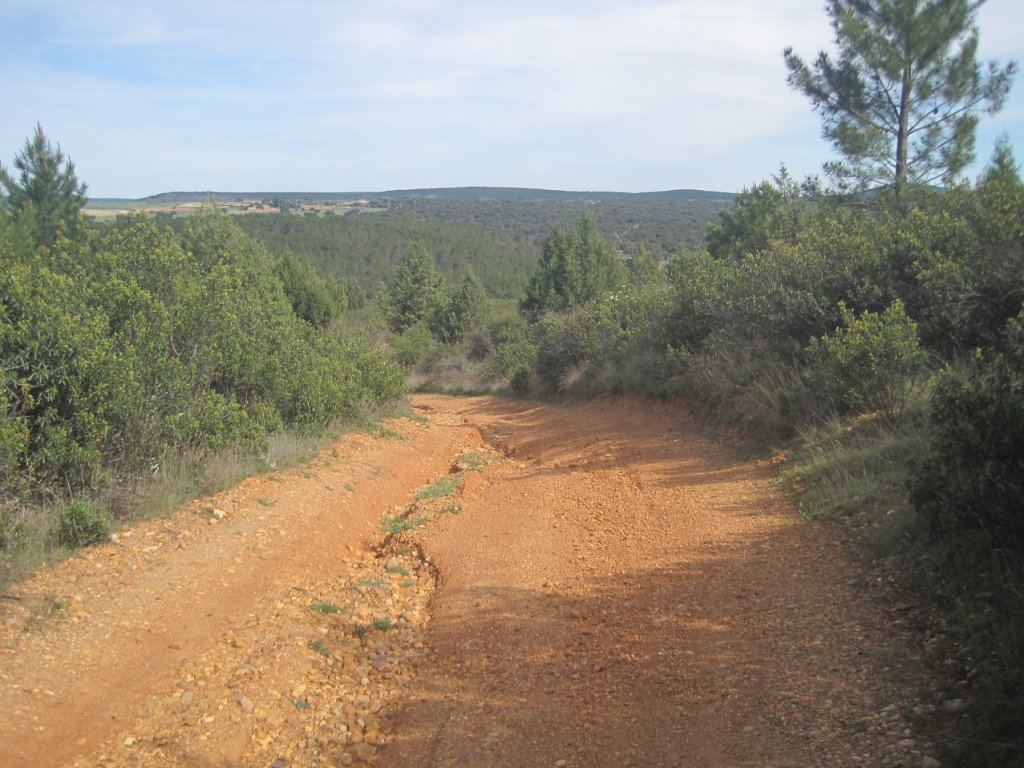
Just off the forest track, almost in sight of Tamajón, I slit a saddlebag on a metal post. It’s a good thing it was here and not before, anyway.
Well, that’s all. In Tamajón I drank my beer and got in the car and went home.
I hope you enjoyed it